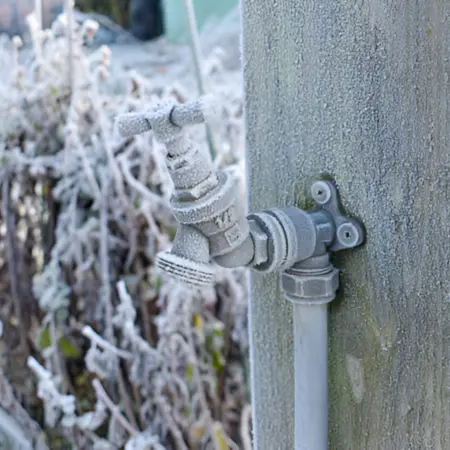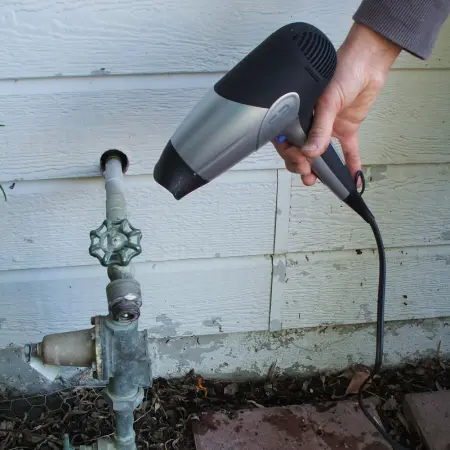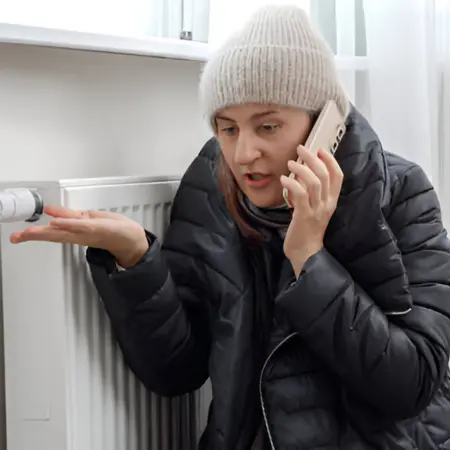When temperatures drop, frozen pipes can become a real concern for homeowners.
This quick guide offers practical steps to prevent freezing and what to do if it happens.
Stay prepared and keep your plumbing safe this winter.
Key Takeaways
- Once you turn off the water and open the faucet, look for the frozen section of the pipe.
- A hairdryer or heat lamp is a good way to melt frozen pipes.
- Soak the towels in warm water, then squeeze them so they’re damp but not dripping.
- Using fire can damage the pipes and create a serious safety risk.
- Calling a plumber if you can’t find where the pipe is frozen is smart.
- A burst pipe can seriously damage your home and cause mold to grow.
- Always keep your thermostat at a steady temperature.
Immediate Steps To Take When Your Pipes Freeze
Taking these steps quickly can help cut damage and restore your plumbing.
1. Turn Off The Water Supply
The first thing to do is turn off the main water supply to your home.
This stops any water from flowing into the pipes, which can prevent further damage if the pipes burst.
Look for the shut-off valve, usually located near the water meter.
Turning it off right away is important to avoid flooding.

2. Open The Faucet
Next, open the faucet that is connected to the frozen pipe.
This allows any pressure that has built up in the pipes to escape.
When the ice starts to melt, water can flow out freely.
This helps prevent the pipe from bursting as it melts, which could happen if there’s nowhere for the water to go.
3. Locate The Frozen Section
After you’ve turned off the water and opened the faucet, check for the frozen part of the pipe.
Look for exposed pipes in cold areas of your home, such as basements and outside walls.
The frozen section may feel colder, and you might notice bumps or frost on the pipe.
Identifying the problem area will help you know where to focus your melting efforts.
How To Safely Melt Frozen Pipes
By following these steps, you can melt your frozen pipes and prevent further damage.
1. Use A Hairdryer Or Heat Lamp
One effective way to melt frozen pipes is by using a hairdryer or a heat lamp.
Set the hairdryer on a low setting and gently move it back and forth over the frozen area.
If you have a heat lamp, place it safely away to warm the pipe gradually.
This method allows the ice to melt slowly without risking damage to the pipe.

2. Wrap Pipes With Warm Towels
Another method is to wrap the frozen pipes with warm towels or rags.
Soak the towels in warm water, then wring them out so they’re wet but not dripping.
Wrap them around the affected pipes, changing them out as they cool.
This gradual warming helps the ice melt slowly and reduces the risk of the pipe bursting.
3. Avoid Open Flames
It’s important to never use open flames, like a blowtorch or matches, to thaw frozen pipes.
Using fire can easily damage the pipes and create a serious safety hazard, including the risk of starting a fire.
Always use safer heat sources like hairdryers, heat lamps, or warm towels.
4. Turn On The Faucet
As you melt the pipes, turn on the faucet connected to the frozen pipe.
Once you notice the ice melting, water will start to flow out.
This helps relieve pressure in the pipe and speeds up the thawing process.
If you don’t see water flow immediately, keep applying heat until it starts to run smoothly.
When To Call A Professional
Getting a professional’s help when you’re unsure what to do can save you a lot of trouble and keep your home safe.
1. When You Can’t Find The Frozen Pipe
Calling a plumber is a good idea if you can’t figure out where the pipe is frozen.
They have special tools and know-how to find pipes you might not see.
It could get worse if you don’t know where the problem is, so it’s better to ask for help.

2. When The Pipes Are Hard To Reach
Sometimes, pipes are hidden in difficult-to-reach places, like behind walls or under the floor.
If the frozen pipes are in these tricky spots, a plumber can help.
They have the right tools to reach those areas without breaking anything.
3. When You Think The Pipe Has Burst
Call a plumber immediately if you notice signs of a burst pipe, like water leaking from the walls or stains.
A burst pipe can cause a lot of damage to your home and lead to mold.
By checking the damage and fixing the pipe, a plumber can help prevent more problems.
How To Prevent Pipes From Freezing In The Future
By taking these steps, you can help protect your pipes from freezing and avoid problems in the future:
1. Insulate (Cover) Exposed Pipes
You can use pipe insulation or heat tape to protect pipes exposed to cold air.
Pipe insulation is a foam sleeve that wraps around the pipes, keeping them warm.
Heat tape is an electric tape that warms up the pipes when it’s cold.
Both options help prevent freezing.
2. Keep A Slow Drip
During very cold weather, let your faucets drip a little.
This slow drip keeps water moving in the pipes, making it less likely to freeze.
Even a tiny stream of water can make a big difference in preventing ice from forming.
3. Seal Gaps And Cracks
Look for any gaps and cracks in the walls or floors near your pipes.
These openings can let in cold air, which can freeze the pipes.
Use foam to seal these gaps and keep the cold out.
This will help keep your pipes warm.
4. Maintain Home Heating
It’s important to keep your home warm during winter.
Set your thermostat (a device that detects temperature) to a constant temperature, even if you’re not home.
This will keep the areas around the pipes warm enough to stop them from freezing.
Conclusion
Frozen pipes can cause big problems, but knowing what to do can help.
You can protect your home and avoid damage by taking quick action and following the right steps. Contact us at OP Plumbing Hub for expert advice.
